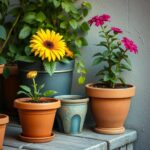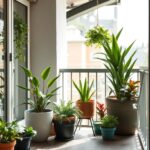How do you put plastic bottles in the bottom of a planter? A Step-by-Step Guide to Improve Drainage and Save Soil

When it comes to gardening, proper drainage is essential for healthy plant growth. One innovative method to enhance drainage while also conserving soil is to use plastic bottles at the bottom of your planters. This step-by-step guide will walk you through the process of incorporating plastic bottles into your planters, ultimately improving drainage and reducing the amount of soil you need. Not only will this technique help your plants thrive, but it also promotes recycling and environmental consciousness. Let’s dive into the simple steps to transform your planters into more efficient and eco-friendly gardening solutions.
How to Effectively Use Plastic Bottles at the Bottom of a Planter
Using plastic bottles at the bottom of a planter is an effective way to enhance drainage and reduce the amount of potting soil needed, making your planters more efficient and eco-friendly. Start by collecting clean, empty plastic bottles (such as water or soda bottles), removing labels, and cutting them in half if necessary. Place the bottles upside down in the planter, ensuring they are evenly distributed to create air pockets that will allow water to flow freely through the soil. This method not only helps with water drainage but also prevents soil from washing away and supports root growth by aerating the soil.
Benefits of Using Plastic Bottles in Planters
Using plastic bottles in planters offers numerous benefits, such as improved drainage, weight reduction, and sustainability. By creating air pockets, the bottles allow excess water to escape, preventing root rot and promoting healthier plant growth. Additionally, using recycled material like plastic bottles reduces waste and lowers the cost of potting mixes, making gardening more accessible and environmentally friendly.
How to Prepare Plastic Bottles for Planters
To prepare plastic bottles for use in planters, first clean them thoroughly to remove any residual liquids or sugars that could attract pests. Remove the labels and caps, as they can impede drainage. Depending on your preference and the size of the planter, you may choose to cut the bottles in half or leave them whole. Whichever method you select, ensure that they are placed upside down within the planter for optimal aeration.
Choosing the Right Size of Plastic Bottles
When selecting plastic bottles for this gardening technique, aim for bottles that are appropriately sized for your particular planter. Smaller bottles may work well in smaller containers, while larger bottles can be beneficial for bigger planters. Consider using a mix of sizes as this can help create various air pockets, enhancing the drainage process and maximizing the planter's efficiency.
See also:
Best Types of Plants for Planters with Plastic Bottles
Almost any plant that requires good drainage can thrive in a planter utilizing plastic bottles. However, succulents, herbs, and small flowering plants tend to do particularly well as they prefer dryer soil conditions. It's important to adjust your planting strategy based on the specific needs of the plants while ensuring that your method of using plastic bottles maintains sufficient drainage for root health.
Maintenance of Planters with Plastic Bottles
Maintaining a planter that incorporates plastic bottles involves regular monitoring of moisture levels and drainage efficiency. Since the bottles increase aeration, it's generally recommended to water less frequently, allowing the soil to dry out between waterings. Check periodically for clogs or issues with drainage and ensure that the bottles remain unobstructed to allow for optimal conditions for your plants.
| Aspect | Plastic Bottles | Traditional Draining Methods |
|---|---|---|
| Drainage Efficiency | High due to air pockets | Dependent on soil type |
| Weight | Lightweight, reduces soil needed | Heavier due to soil |
| Sustainability | Recycling plastic | May require new materials |
| Cost | Low, utilizes waste materials | Can be higher with soil amendments |
| Plant Variety | Suitable for various plants | Varies by method |
Benefits of Using Plastic Bottles in Planters
Using plastic bottles at the bottom of your planter can significantly improve drainage and reduce the amount of soil needed, making it a sustainable choice for gardening. The bottles create air pockets, allowing excess water to flow freely instead of becoming trapped in the soil, which can lead to root rot. This method also helps in conserving resources by repurposing materials that would otherwise end up in a landfill. Additionally, it lightens the overall weight of the planter, making it easier to move and manage, while still providing a healthy environment for your plants to thrive.
Choosing the Right Plastic Bottles
When selecting plastic bottles for your planter, consider using those that are clean and free from any residue. Bottles with a cap can also be beneficial, as they help retain air within the bottle, promoting better drainage. It's advisable to opt for larger bottles, such as 1.5-liter or 2-liter sizes, since they occupy more space, allowing for better water circulation and drainage within the soil. Be sure to remove labels to avoid any potential contamination.
Preparing the Bottles for Use
Before placing the plastic bottles in the planter, it's essential to prepare them properly. Start by rinsing them thoroughly to remove any remaining elements that might harm your plants. Subsequently, you can cut the bottles in half or leave them whole, depending on your preference. If you choose to cut them, make sure to create openings along the sides to enhance water flow. This preparation ensures that the bottles serve their purpose effectively, promoting better drainage without accumulating debris.
See also:
Arranging Bottles at the Bottom of the Planter
To facilitate optimal drainage, arrange the plastic bottles in a single layer at the bottom of the planter. Fill the planter with the bottles, ensuring they are evenly spaced out to maximize airflow. You can fill any remaining gaps with smaller items like rocks or pebbles, which will allow for increased drainage while preventing the soil from passing through the gaps. This arrangement is vital for creating an efficient drainage system that benefits plant growth.
Adding Soil Above the Bottles
Once you have positioned the plastic bottles correctly, it's time to add the soil. Choose a high-quality potting mix tailored for your specific plants, as it will provide the necessary nutrients while still allowing for proper drainage. Fill the planter to the desired level, ensuring to leave space for your plants. Gently pat down the soil to eliminate any large air pockets but be careful not to compact it too much, as this can restrict root growth and water infiltration.
Monitoring Drainage and Plant Health
After planting your flowers or vegetables, it’s crucial to monitor the drainage and overall health of your plants regularly. Pay attention to any signs of overwatering, such as yellowing leaves or soggy soil, and adjust watering schedules accordingly. Inspect the drainage system created by the bottles by observing how quickly water drains after a watering session. Maintenance checks will ensure that both your plants and the plastic bottles continue to serve their purpose effectively, contributing to a thriving garden.
Questions from Our Readers
How do you prepare plastic bottles for use in a planter?
To prepare plastic bottles for a planter, first, clean the bottles thoroughly to remove any residue. Then, cut the bottles in half or make several drainage holes in the bottom to allow excess water to escape. This helps in creating a suitable environment for the plants.
What is the purpose of putting plastic bottles in the bottom of a planter?
The purpose of placing plastic bottles at the bottom of a planter is to create space for better drainage and reduce the amount of potting soil needed. This method helps prevent root rot and allows for more efficient water management within the planter.
See also:
Can any type of plastic bottle be used in a planter?
Yes, most types of plastic bottles can be used in a planter, but it's best to use recyclable and non-toxic plastics, such as PET bottles. Ensure that the bottles are in good condition without any leaks or cracks that could affect their functionality.
How many plastic bottles should be used in the bottom of a planter?
The number of plastic bottles to use in the bottom of a planter depends on the size of the planter and the bottles themselves. Generally, using a few bottles is enough to create adequate space for drainage without compromising the overall planting area.

If you want to read more articles like How do you put plastic bottles in the bottom of a planter? A Step-by-Step Guide to Improve Drainage and Save Soil, we recommend you check out our Planter category.
Leave a Reply
Related Articles